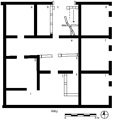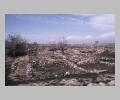| Context: | Olynthus |
| Type: | House |
| Summary: | Well-built house near the Agora of Olynthus, with three shops. |
| Date: | ca. 432 BC - ca. 348 BC |
| Dimensions: | Ca. 17 m. square. |
| Period: | Classical/Late Clas. |
Plan:
Domestic portion of house fairly regular in plan, with very small paved court, pastas, kitchen complex and storerooms in SW; unusual "light well" (?) entrance; three large shops take up east part of house; second story with separate entrance from lower.
Date Description:
Not built before 432 BC, when this part of Olynthus was planned and laid out; destroyed by Philip II in 348 BC.
Other Notes:
A iv 9 lies in as the center of downtown Olynthus, adjoining the agora and opening onto Avenue B. It was well preserved under between 1 and 1.8 m of fill. The hill slopes off to the east here, and the the eastern part of the house lies at a lower level than the west, the house being terraced at two levels. The eastern third of the house, facing onto Avenue B, was taken up by three shops (d, f, l), of roughly equal size. The rest of the house conforms more or less to standard layout: a small court, a pastas extending the width of the domestic area of the house; one "North Room" (a) and an interesting suite (b-c); a kitchen complex south of the court and two rooms, g and i, in the southwest corner of the house. The construction is better than usual, with drafted ashlar masonry on the east and part of the north wall, two rooms with painted walls, and a number of stone architectural elements.
The entrance to the house leads into room c. The door was of the prothyron type, whose four bases are still preserved; but extending from the southeastern base is another series of worked stones. This is probably a stairbase, but here opening to the outside of the house, rather than to the interior. The upper floor, therefore, may have been either a separate dwelling with its own entrance from the street, or some other kind of separate space.
The pastas was originally divided from the court by a colonnade, but the intercolumniations were later partly walled off, perhaps to a height of only about a meter or so, leaving a doorway just west of the central pillar. Its walls were painted red with a white baseboard. Against the south wall of the pastas, just east of the door into room g, was found a terracotta louter base in situ, whose basin was found across the room near the door to room a. A storage amphora rested nearby against the south wall, as at the House of Many Colors, and perhaps for the same purpose, to hold water for washing. However, there were no portable altars in the pastas, and this louter was probably used for domestic washing and other tasks rather than for ritual purification. There is less evidence of furniture here than at some other houses at Olynthus, but the distribution of finds near the walls suggests that the east and west walls had shelves or other furniture: part of a red-figure pelike was found in the northeast corner, a one-handled cup in the southeast corner, while three lamps were found against the west wall. Three shallow bowls were also found in the pastas, as well as three loomweights and a spindle whorl, a swinging handle attachment from a bronze vessel, and seven coins. While the pastas does not show the quantity and variety of finds and so, presumably, of activities as some others, its uses seem in general similar, including washing and shelving of some domestic vases and equipment.
Room a, painted red with a buff baseboard, was apparently used for weaving: thirty-one loomweights, or about one loom's worth, were found in the room. The room also contained a mold for a terracotta figurine — another was found in the court, and it is possible that figurines were produced in this house.
Rooms b and c probably formed a light well like those at the House of Many Colors and the Villa of the Bronzes. There were few finds in either of these rooms.
In the southeast corner of room c was a peculiar hollow rectangle of stone and mudbrick, plastered in places, and drained by an open drain of reused rooftiles, which, at least as preserved, did not continue all the way out the door of the house. Graham suggested first that the rectangle might be the foundation of a cupboard, and later that it might have supported the stairs to the upper story; but it is far too flimsy to have supported the weight of a staircase. Within this rectangle were found the base of a marble louter, standing upright, and a portable altar. The reconstruction of the structure is problematic, but it might have formed or supported a kind of domestic shrine, the louter here used for ritual rather than general domestic washing, and the drain, which in any case could not have handled large amounts of runoff, intended for liquid offerings. The assemblage might thus be similar to those in the pastades of the House of Many Colors and the Villa of the Bronzes.
The court of this house was rather small, but well cobbled and drained by a pipe leading out the front door of the house. Pithoi were set into the floor in two corners, to catch water from the gutters. A marble louter base, inscribed
Sources Used:


